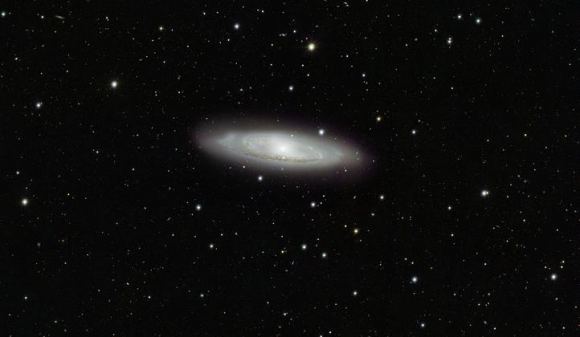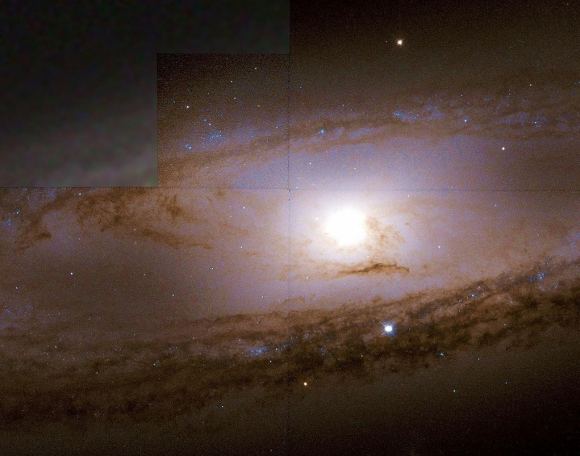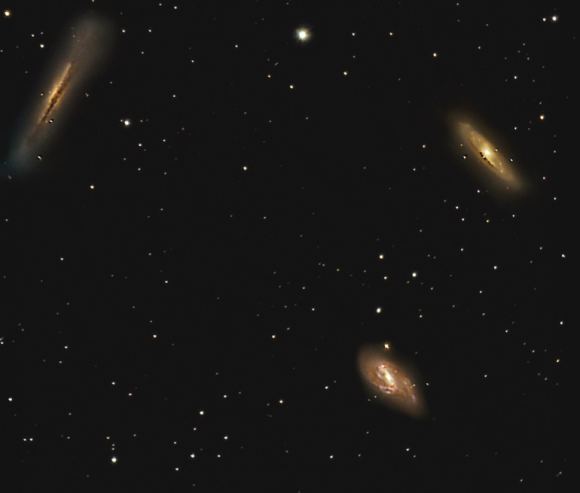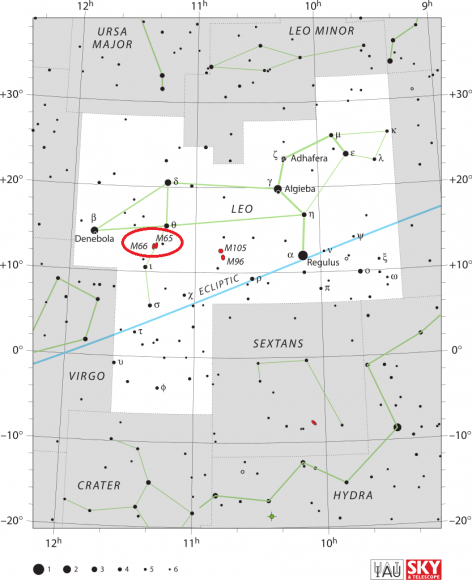Welcome back to Messier Monday! Today, we continue in our tribute to our dear friend, Tammy Plotner, by looking at the intermediate spiral galaxy known as Messier 65.
In the 18th century, while searching the night sky for comets, French astronomer Charles Messier kept noting the presence of fixed, diffuse objects he initially mistook for comets. In time, he would come to compile a list of approximately 100 of these objects, hoping to prevent other astronomers from making the same mistake. This list – known as the Messier Catalog – would go on to become one of the most influential catalogs of Deep Sky Objects.
One of these objects is the intermediate spiral galaxy known as Messier 65 (aka. NGC 3623), which is located about 35 million light-years from Earth in the Leo constellation. Along with with Messier 66 and NGC 3628, it is part of a small group of galaxies known as the Leo Triplet, which makes it one of the most popular targets among amateur astronomers.
Description:
Enjoying life some 35 million light years from the Milky Way, the group known as the “Leo Trio” is home to bright galaxy Messier 65 – the westernmost of the two M objects. To the casual observer, it looks like a very normal spiral galaxy and thus its classification as Sa – but M65 is a galaxy which walks on the borderline. Why? Because of close gravitational interaction with its nearby neighbors. Who can withstand the draw of gravity?!

Chances are very good that Messier 65 is even quite a bit larger than we see optically as well. As E. Burbidge (et al) said in a 1961 study:
“A fragmentary rotation-curve for NGC 3623 was obtained from measures of the absorption features Ca ii X 3968 and Na I X 5893 and the emission lines [N ii] X 6583 and Ha. The measures from two outer regions are discordant if only circular velocities are assumed, and it is concluded that the measured velocity of one of these regions-the only prominent H ii region in the galaxy-has a large non-circular component. The approximate mass derived from the velocity in the outer arm relative to the center is 1.4 X 1011 M0. It is concluded that the total mass is larger than this, perhaps between 2 and 3 X 1011 M0. This would suggest that the mass-to-light ratio in solar units (photographic) for this galaxy, which is intermediate in type between Sa and Sb, lies between 10 and 20.”
But just how much interaction has been going on between the three galaxies which coexist so closely? Sometimes it takes things like studying in multicolor photometry data to understand. As Zhiyu Duan of the Chinese Academy of Sciences Astronomical Observatory indicated in a 2006 study:
“By comparing the observed SEDs of each part of the galaxies with the theoretical ones generated by instantaneous burst evolutionary synthesis models with different metallicities (Z = 0.0001, 0.008, 0.02, and 0.05), two-dimensional relative age distribution maps of the three galaxies were obtained. NGC 3623 exhibits a very weak age gradient from the bulge to the disk. This gradient is absent in NGC 3627. The ages of the dominant stellar populations of NGC 3627 and NGC 3628 are consistent, and this consistency is model independent (0.5-0.6 Gyr, Z = 0.02), but the ages of NGC 3623 are systematically older (0.7-0.9 Gyr, Z = 0.02). The results indicate that NGC 3627 and NGC 3628 have undergone synchronous evolution and that the interaction has likely triggered starbursts in both galaxies. The results indicate that NGC 3627 and NGC 3628 have undergone synchronous evolution and that the interaction has likely triggered starbursts in both galaxies. For NGC 3623, however, the weak age gradient may indicate recent star formation in its bulge, which has caused its color to turn blue. Evidence is found for a potential bar existing in the bulge of NGC 3623, and my results support the view that NGC 3623 does interact with NGC 3627 and NGC 3628.”

So, let’s try looking at things in a slightly different color – integral-field spectroscopy. As V.L. Afanasiev (et al) said in a 2004 study:
“The mean ages of their circumnuclear stellar populations are quite different, and the magnesium overabundance of the nucleus in NGC 3627 is evidence for a very brief last star formation event 1 Gyr ago whereas the evolution of the central part of NGC 3623 looks more quiescent. In the center of NGC 3627 we observe noticeable gas radial motions, and the stars and the ionized gas in the center of NGC 3623 demonstrate more or less stable rotation. However, NGC 3623 has a chemically distinct core – a relic of a past star formation burst – which is shaped as a compact, dynamically cold stellar disk with a radius of ?250-350 pc which has been formed not later than 5 Gyr ago.”
Now, let’s take a look at that gas – and the properties for the gases that exist and co-exist in the galactic trio. As David Hogg (et al) explained in a 2001 study:
“We have studied the distribution of cool, warm, and hot interstellar matter in three of the nearest bright Sa galaxies. New X-ray data for NGC 1291, the object with the most prominent bulge, confirm earlier results that the ISM in the bulge is dominated by hot gas. NGC 3623 has a lesser amount of hot gas in the bulge but has both molecular gas and ionized hydrogen in the central regions. NGC 2775 has the least prominent bulge; its X-ray emission is consistent with an origin in X-ray binary stars, and there is a strict upper limit on the amount of molecular present in the bulge. All three galaxies have a ring of neutral hydrogen in the disk. NGC 3623 and NGC 2775 each have in addition a molecular ring coincident with the hydrogen ring. We conclude that even within the morphological class Sa there can be significant differences in the gas content of the bulge, with the more massive bulges being likely to contain hot, X-ray–emitting gas. We discuss the possibility that the X-ray gas is part of a cooling flow in which cool gas is produced in the nucleus.”

Even more studies have been done to take a look a disc properties associated with M65. According to M. Bureau (et al);
“NGC 3623 (M 65) is another highly-inclined galaxy in the Leo group, but it is of much later type than NGC 3377, SABa(rs). It is part of the Leo triplet with NGC 3627 and NGC 3628 but does not appear to be interacting. NGC 3623’s kinematics an has barely been studied and observations provide a glimpse of its dynamics. The large-scale velocity reveals minor-axis rotation, in agreement with the presence of a bar. In addition, a quasi edge-on disk is present in the center, where the iso velocity contours flatten out abruptly.”
History of Observation:
Both M65 and M66 were discovered on the same night – March 1, 1780 – by Charles Messier, who described M65 as “Nebula discovered in Leo: It is very faint and contains no star.” Sir William Herschel would later observe M65 as well, describing it as “A very brilliant nebula extended in the meridian, about 12′ long. It has a bright nucleus, the light of which suddenly diminishes on its border, and two opposite very faint branches.”
However, it would be Lord Rosse who would be the first to see structure: “March 31, 1848. – A curious nebula with a bright nucleus; resolvable; a spiral or annular arrangement about it; no other portion of the nebula resolved. Observed April 1, 1848 and April 3, with the same results.”
Locating Messier 65:
Even though you might think by its apparent visual magnitude that M65 wouldn’t be visible in small binoculars, you’d be wrong. Surprisingly enough, thanks to its large size and high surface brightness, this particular galaxy is very easy to spot directly between Iota and Theta Leonis. In even 5X30 binoculars under good conditions you’ll easy see both it and M66 as two distinct gray ovals.

A small telescope will begin to bring out structure in both of these bright and wonderful galaxies, but to get a hint at the “Trio” you’ll need at least 6″ in aperture and a good dark night. If you don’t spot them right away in binoculars, don’t be disappointed – this means you probably don’t have good sky conditions and try again on a more transparent night. The pair is well suited to modestly moonlit nights with larger telescopes.
Capture one of the Trio tonight! And here are the quick facts on this Messier Object:
Object Name: Messier 65
Alternative Designations: M65, NGC 3623, (a member of the) Leo Trio, Leo Triplet
Object Type: Type Sa Spiral Galaxy
Constellation: Leo
Right Ascension: 11 : 18.9 (h:m)
Declination: +13 : 05 (deg:m)
Distance: 35000 (kly)
Visual Brightness: 9.3 (mag)
Apparent Dimension: 8×1.5 (arc min)
We have written many interesting articles about Messier Objects here at Universe Today. Here’s Tammy Plotner’s Introduction to the Messier Objects, M1 – The Crab Nebula, and David Dickison’s articles on the 2013 and 2014 Messier Marathons.
Be to sure to check out our complete Messier Catalog. And for more information, check out the SEDS Messier Database.
Sources:

